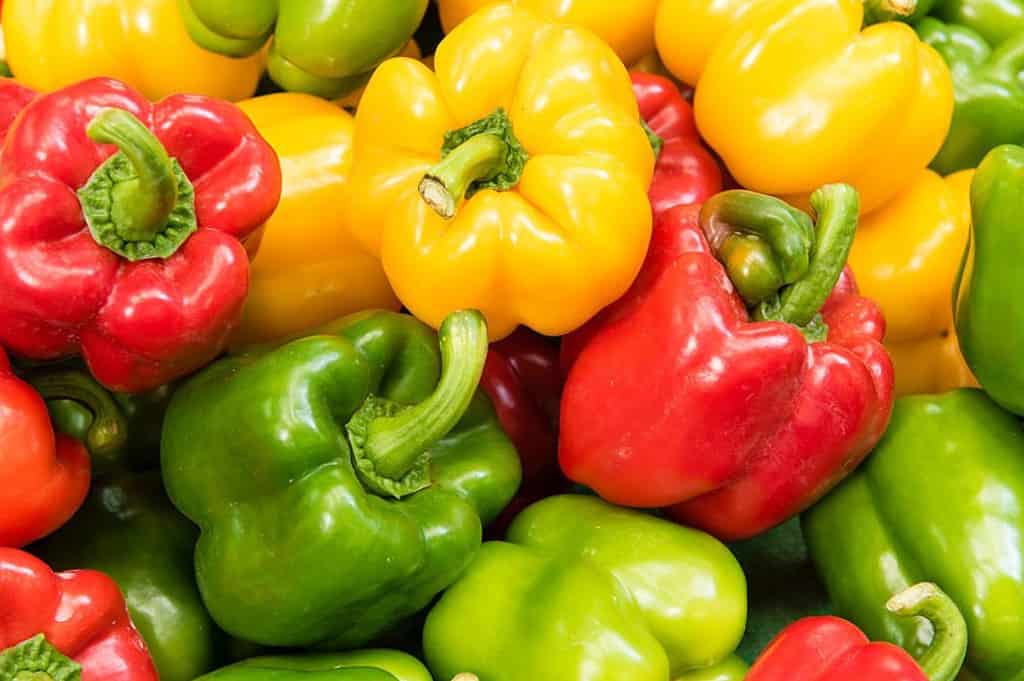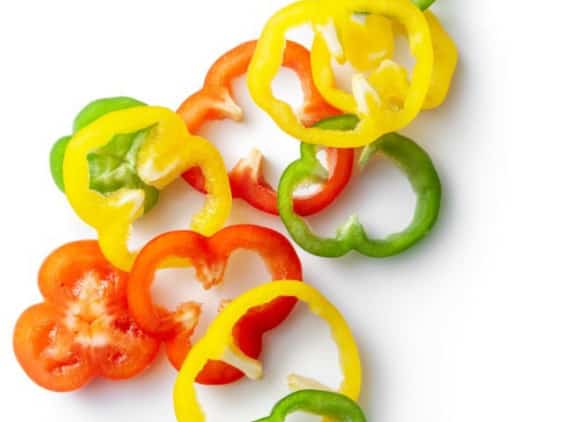So can dogs eat bell peppers? Dogs can occasionally consume bell peppers as a wholesome, low-calorie, healthy treat. They are an excellent alternative to high-fat, high-calorie treats. These veggies are nutrition-dense! Provided you thoroughly wash them and eliminate the seeds and core, bell peppers can bestow numerous health advantages for your canine companion.
What Are Bell Peppers?
Bell peppers are fondly referred to as the Christmas ornaments of the vegetable world due to their vibrant colors. These fruits are harvested from the Capsicum annuum plant.
Native to regions in Central and South America, bell peppers have low levels of capsaicin. They are not spicy foods at all, unlike their chili pepper siblings.
They come in a variety of colors, each one marking a different stage of ripeness with slight flavor variations. Bell peppers are highly nutritious foods, packing an impressive source of vitamins A, E, and B6.
Lots of antioxidants like lutein and beta carotene present in them contribute positively towards skin health for humans and dogs alike.

Different Types of Peppers: Red, Green, Yellow, Orange
Bell peppers are a popular addition to many dishes globally. Each type of pepper has unique nutritional profiles, which influence their health impacts on dogs:
- Red Bell Peppers: Red peppers are packed with essential nutrients, known as the maturation form of green bell peppers. They boast high quantities of Vitamins A, E, B6, and lutein. These vitamins contribute significantly to the overall health of your dog’s immune system, skin, and coat.
- Green Bell Peppers: Although they hold fewer vitamins than their red counterpart, green peppers still offer valuable health benefits for dogs. Apart from being an ideal snack with low calories, these sweet peppers provide Vitamin C and beta-carotene – assisting in bolstering your pet’s immune system.
- Yellow Bell Peppers: Noteworthy for their sweet flavor and vibrant coloration, yellow peppers have similar nutritional value but also contain some form of Vitamin A.
- Orange Bell Peppers: The orange varieties falls between the red and yellow varieties in sweetness. Regarding nutritional content for dogs’ health, these sweet peppers are rich in Vitamins A & C and a good source of dietary fiber.
Are Bell Peppers Safe For Dogs?
Nutritious bell peppers are a safe and healthiest option for dogs. They make a great option for regular treats and can benefit when given properly. Keep the amounts of vegetables low and cook well to eliminate the crunchy texture.
General Safety Concerns
Feeding your furry friend this occasional dog treat requires some caution. Despite their safety and additional health benefits, there’s a need to watch out for potential choking hazards. The stem and pepper seeds must be removed before serving.
Also important is gradually introducing this alternative snack into your dog’s diet. Going slow helps identify possible allergies or sensitivities that may surface in response to the new food item. Signs could range from stomach issues to adverse reactions on the dogs skin.
Ensure that your pet experiences enjoyment rather than signs of discomfort during meals. Consult the vet for advice about incorporating bell peppers into the canine diet responsibly and effectively.
Health Benefits Of Bell Peppers For Dogs
Bell peppers offer real health benefits for dogs. Bell peppers contain antioxidants that help fight against free radicals in the body. Adding bell peppers to a dog’s diet can provide digestive support and improve their energy levels.
Vitamins And Minerals
Bell peppers are packed with huge amounts of vitamins and minerals. They are particularly rich in vitamin A, essential for maintaining healthy skin, coat, and eye health in dogs.
Bell peppers also contain high levels of vitamin C, a powerful antioxidant that supports a strong immune system in dogs. They are an excellent vitamin E and B6 source, crucial in various bodily functions for your furry friend.
The boost of vitamins works together and ensures your dog stays happy and healthy. Incorporating bell peppers into their diet can boost their daily food intake nutritiously while providing them with a crunchy snack they’ll love.

Antioxidants
Bell peppers are packed with antioxidants that help protect the body against free radicals and oxidative stress. They can lead to cell damage and various diseases.
The antioxidants in bell peppers, like vitamins A, E, and C, boost a dog’s immune system. These potent compounds also promote healthy digestion by reducing inflammation in the gastrointestinal tract.
Digestive Support
Bell peppers provide digestive support for dogs due to their high fiber content. A source of fiber maintains a healthy digestive system in dogs. It helps regulate bowel movements and prevent constipation.
Bell peppers contain enzymes that aid digestion, promoting better nutrient absorption and overall gut health. Including bell peppers in your dog’s diet will help keep their digestive health in check and ensure optimal nutrient utilization.
Risks Associated With Feeding Your Dog Bell Peppers
Feeding your dog bell peppers can pose certain risks, including allergies and overconsumption concerns. Check the amounts of bell peppers being given to be safe.
Potential Allergies
Some dogs may have allergies or sensitivities to bell peppers. While most dogs can tolerate bell peppers without issues, monitor their reaction when introducing this new food.
Signs of allergic reactions in dogs may include itching, redness, swelling, hives, or gastrointestinal discomfort like vomiting or diarrhea. If you notice these symptoms, avoid giving them this food and consult a veterinary nutritionist.
Overconsumption Concerns
Feeding your dog too many bell peppers can lead to fuzzy pet health. While these vegetables are safe for dogs, in moderation, include them in their diet. Excessive consumption can cause digestive upset. Variety is essential for a balanced and healthy diet, so do not rely solely on bell peppers as regular common snacks.
How To Safely Feed Bell Peppers To Dogs?
To safely feed bell peppers to dogs, remove the seeds and stem before giving them to your furry friend.
Preparing The Bell Peppers
To prepare bell peppers for your dog, follow these simple steps:
- Wash the bell peppers thoroughly under cool running water to remove dirt or residue.
- Cut off the top stem of the bell pepper variety and discard it.
- Cut slices of bell peppers in half and remove the seeds and inner white membrane with a spoon.
- Chop the 1-3 medium slices into small, bite-sized pieces that are easy for your dog to consume. Larger pieces pose a choking hazard.
- You can serve the bell peppers raw or lightly steam them for a softer texture. Since the outer skin can sometimes be tough to eat, steaming will help.
- You can also puree the bell peppers to mix them with your dog’s regular food for added nutrition.
How To Feed Dogs Peppers?
To determine the correct quantity of bell peppers to feed your dog, check the size of your dog. Larger dogs can generally consume more than smaller dogs. Introduce bell peppers in moderation into your dog’s diet and observe how they respond. As with any alternative treats, minimize them to 10 percent or less than their daily treat calories.
Pet parents must remember to give these sweet bells to their dogs in moderation. Feeding too many bell peppers at once may lead to an upset stomach or digestive issues. A veterinary consultant is a must if you have any concerns.
FAQs About Dogs And Bell Peppers
Can Dogs Eat Raw Bell Peppers?
Raw bell peppers are safe for dogs to eat and can be a nutritious and tasty snack. They are packed with vitamin B6, A, E, lutein, etc., and benefit dog health. Raw peppers also contain vitamin C and beta-carotene, which support a dog’s immune system.
Can Dogs Eat Red And Yellow Bell Peppers?
Red and yellow bell peppers are safe for dogs to eat and can provide various health benefits. Red color bell peppers contain the most vitamins and antioxidants. These healthy nutrients support a robust immune system in dogs. Yellow peppers are a source of vitamin C and beta-carotene, which promote healthy skin, coat, and eye health in dogs.
Are Green Bell Peppers Safe For Dogs?
Green peppers are safe for dogs and contain vitamins A, E, B6, and lutein. These vitamins support a dog’s immune system, skin, coat, and eye health. Green bell peppers are also a good source of vitamin C and antioxidant beta-carotene.
Can Dogs Eat Bell Peppers Cooked?
Cooked peppers are safe for dogs and can be a tasty addition to their diet. When bell peppers are cooked, they become softer and more manageable to chew and digest. The cooking process breaks down some of the stricter fibers, making it more easily digestible for your pup.
However, not all seasonings or cooking methods are safe for dogs. Avoid adding spices or additional ingredients that may harm your dog, like onions or garlic.
Can Dogs Eat Spicy Peppers?
Spicy peppers, like chili peppers, should be avoided when feeding your dog. These hot peppers contain high amounts of capsaicin, which can cause stomach irritations and severe discomfort for dogs.
Ingesting spicy peppers can lead to diarrhea and vomiting in our canine companions. Stick with mild bell peppers that are safe for dogs instead of spicy varieties.
Foods To Avoid For Dogs: A Quick Overview
Certain human food can be dangerous or toxic to dogs, including avocados, grapes, macadamia nuts, chocolate, onions, garlic, and anything containing xylitol.
Avocado
Your dog should avoid avocados to prevent harmful effects. Avocados contain persin, which can cause vomiting and diarrhea in dogs. The high-fat content in avocados can lead to gastrointestinal issues, pancreatitis, and adverse effects in dogs.
Grapes
Grapes should be avoided by dogs at all costs. They can be highly toxic and lead to health conditions like kidney failure.
Immediate veterinary advice is crucial if a dog accidentally ingests grapes or raisins. Symptoms of grape toxicity in dogs are vomiting, diarrhea, abdominal discomfort, decreased appetite, and lethargy.
Macadamia Nuts
Macadamia nuts can be highly toxic to our canine friends, causing weakness, vomiting, tremors, and hyperthermia. The exact reason why these nuts cause negative health effects in dogs remains unknown.
Chocolate
Chocolate is highly toxic to dogs and should never be fed to them. It contains theobromine, which can cause vomiting, diarrhea, rapid breathing, increased heart rate, muscle tremors, and even seizures.
The darker the chocolate, the higher the concentration of theobromine it contains. Even small amounts of chocolate can be dangerous for dog heart health. Keep all chocolate products away from the kitchen counter or other accessible spots and avoid giving them as an occasional treat or reward.
Onions And Garlic
Onions and garlic should always be avoided in a dog’s diet. These aromatic vegetables contain compounds that damage a dog’s red blood cells, leading to adverse health issues like anemia. Both onions and garlic can also cause stomach upset in dogs, including vomiting and diarrhea.
Xylitol
Xylitol is a toxic substance that is harmful to dogs. It is a sugar substitute commonly found in gum, candy, baked goods, and peanut butter.
While it may be safe for humans, even small amounts of xylitol cause a rapid release of insulin in dogs. It leads to low blood sugar levels, weakness, seizures, liver failure, and other negative reactions.
Keep products containing xylitol out of your dog’s reach, and read ingredient labels carefully before offering any treats or foods.
Conclusion: Are Bell Peppers A Healthy Snack For Dogs?
Bell peppers can be a healthy snack for dogs. They are rich in vitamins and antioxidants, supporting the immune system, skin, and eye health. However, stay away from the spicier peppers.
Go the low-calorie way with these sweet treats. Introduce the sweet bell peppers slowly and monitor your dog’s reaction, as some may have allergies or sensitivities. Remove the seeds and stem, and cut the bell pepper into bite-sized pieces before feeding them. So go ahead and share these tasty treats with your pup!
Author Profile
- Site Owner And Dog Lover
-
Aritra, the founder of Labradorandyou.com, is a lifelong dog lover whose passion ignited for Labradors for their loyalty and intelligence. With extensive research and personal experiences, Aritra has become a Labrador expert, offering a rich resource on the breed. Labradorandyou.com provides reliable, timely, and evidence-based information, including Labrador-specific product reviews, training techniques, and care tips.
Labradorandyou.com was born out of Aritra's passion and his desire to share his profound knowledge about the breed. The site serves as a comprehensive resource, offering a wealth of up-to-date information for Labrador owners and enthusiasts alike
Also by the author
-
 Lab-TypesNovember 17, 2023Old Dog Seizures: Causes, Symptoms, and Treatment Options
Lab-TypesNovember 17, 2023Old Dog Seizures: Causes, Symptoms, and Treatment Options
-
 Lab-TypesNovember 17, 2023Why Is My Dogs Poop Yellow? 8 Reasons & Solutions
Lab-TypesNovember 17, 2023Why Is My Dogs Poop Yellow? 8 Reasons & Solutions
-
 ReviewsNovember 17, 2023The Only Hill’s Science Diet Review You Need To Read
ReviewsNovember 17, 2023The Only Hill’s Science Diet Review You Need To Read
-
 Lab-TypesNovember 17, 2023How To Adopt An Emotional Support Dog?
Lab-TypesNovember 17, 2023How To Adopt An Emotional Support Dog?





